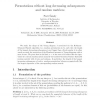570 search results - page 5 / 114 » On the number of zero-sum subsequences |
IJCAI
2007
13 years 11 months ago
2007
Time series data abounds in real world problems. Measuring the similarity of time series is a key to solving these problems. One state of the art measure is the longest common sub...
AAIM
2007
Springer
14 years 1 months ago
2007
Springer
Abstract. The Longest Common Subsequence (LCS) problem is a classic and well-studied problem in computer science. The LCS problem is a common task in DNA sequence analysis with man...
COMBINATORICS
2007
13 years 9 months ago
2007
We study the shape of the Young diagram λ associated via the Robinson– Schensted–Knuth algorithm to a random permutation in Sn such that the length of the longest decreasing ...
FOCS
2007
IEEE
14 years 4 months ago
2007
IEEE
We show that any deterministic data-stream algorithm that makes a constant number of passes over the input and gives a constant factor approximation of the length of the longest i...
KDD
1999
ACM
14 years 2 months ago
1999
ACM
Most time series comparison algorithms attempt to discover what the members of a set of time series have in common. We investigate a di erent problem, determining what distinguish...

